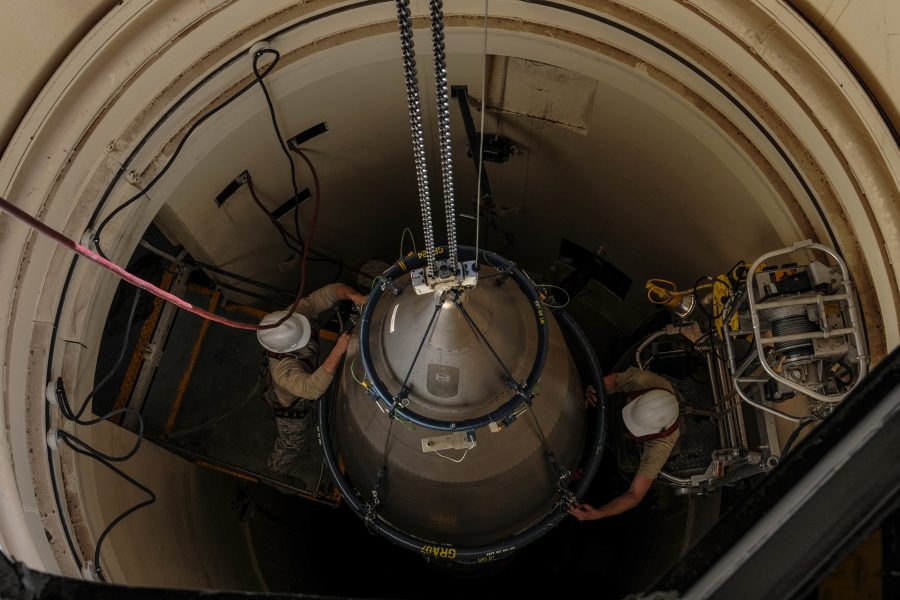The Air Force has spent more than two years studying cancer risks to Airmen who work with the service’s intercontinental ballistic missiles. Now lawmakers in Congress are placing fresh scrutiny on the issue and have prepared legislation that would direct the service to clean silos and launch facilities.
Draft versions of the annual defense policy bill from both houses of Congress each contain provisions regarding the safety of ICBM facilities and the Air Force’s investigation of potential increased cancer rates among those who have worked on the sites.
In the latest update to its Missile Community Cancer Study, Air Force officials said in June that they had found preliminary indications that missileers were slightly more at risk to be diagnosed with cancer than the general population.
A “health risk assessment characterizes the health risk as low but not zero,” Col. Ric Speakman, the commander of the U.S. Air Force School of Aerospace Medicine, which is running the study, said during a town hall event. “Therefore, the appropriate action is to include missile alert facility workers in an occupational surveillance.”
Congress is looking to take more action.
The Senate version of the draft 2026 National Defense Authorization Act calls for the Air Force to conduct a “deep cleaning” of its Minuteman III launch control centers every five years. There are 45 LCCs—underground crew capsules where Airmen operate ground-based nuclear weapons—spread across Montana, Wyoming, North Dakota, and Colorado, supporting 450 silos, 400 of which are operational.
The cleaning would continue until the launch control centers are decommissioned as the new Sentinel intercontinental ballistic missiles replace the Minuteman III fleet in the coming years. Sentinel will have new and fewer underground facilities for Airmen.
The current facilities were first deep-cleaned in 2014 as a “quality of life” undertaking, per an Air Force release at the time. During the June town hall, Air Force officials said there was a “deep cleaning contract in progress.”
The Air Force also has a separate contract for the remediation of polychlorinated biphenyls (PCBs), a likely carcinogen, at ICBM facilities should the need arise in the future. Four launch control centers were found to have levels of PCBs that required remediation.
Air Force Global Strike Command said in June that its deep cleaning would increase the focus on intake and exhaust ducts and chemical, biological, and radiological filters.
A health risk assessment for current Airmen conducted by the Air Force flagged the presence of benzene, “which was detected in trace amounts in a few of the LCCs,” according to a June 5 release from Air Force Global Strike Command. PCBs and chloroform drove “a smaller portion of the increased risk,” according to AFGSC. The Air Force said the levels of benzene and chloroform were “well below standards for remediation.”
The Senate’s language appeared to be in line with AFGSC’s current plans, though it does not spell out exactly what constitutes a “deep cleaning.”
“There is continuous cleaning by personnel and facility managers, but there is also a deep cleaning conducted,” an Air Force Global Strike Command spokesperson said. “A deep cleaning happens annually and has for years.”
The spokesperson noted there are two types of cleaning the command plans to conduct in the future and is contracted for at its wings—the regular deep cleaning, which the spokesperson likened to “extremely thorough spring cleaning”—and separate remediation of harmful substances.
“The second type of cleaning is PCB remediation,” the spokesperson said. “PCB remediation was targeted first where PCBs were found and has been accomplished. We have a contract to conduct remediation if any future PCBs are detected. This cleaning follows methods to remediate PCB levels to below threshold levels. If the area cannot be remediated, maintenance procedures have been developed to refabricate and replace contaminated panels.”
Lawmakers are also likely to examine the Air Force’s overarching study further. The House NDAA includes an amendment from Rep. Don Bacon (R-Neb.), a former Air Force one-star general, that orders the National Academies to independently review the findings of the Air Force’s missile community cancer study as well as to run its own study of the occupational health and safety hazards facing Airmen at Minuteman III missile facilities. Those findings are due 18 months after the bill becomes law.
The Air Force has insisted that its current study, designed by the U.S. Air Force School of Aerospace Medicine, is rigorous and may wrap up before the end of the year. But the service dismissed cancer concerns in studies in 2001 and 2005. AFGSC commander Gen. Thomas A. Bussiere has expressed public dissatisfaction with those surveys.
“Let’s make sure that we have some outside experts working with the Air Force studying cancer rates with our ICBM missions,” Bacon said in a July 30 post on X. “We want to ensure credibility and that whatever results come out, we’ve done total due diligence.”


